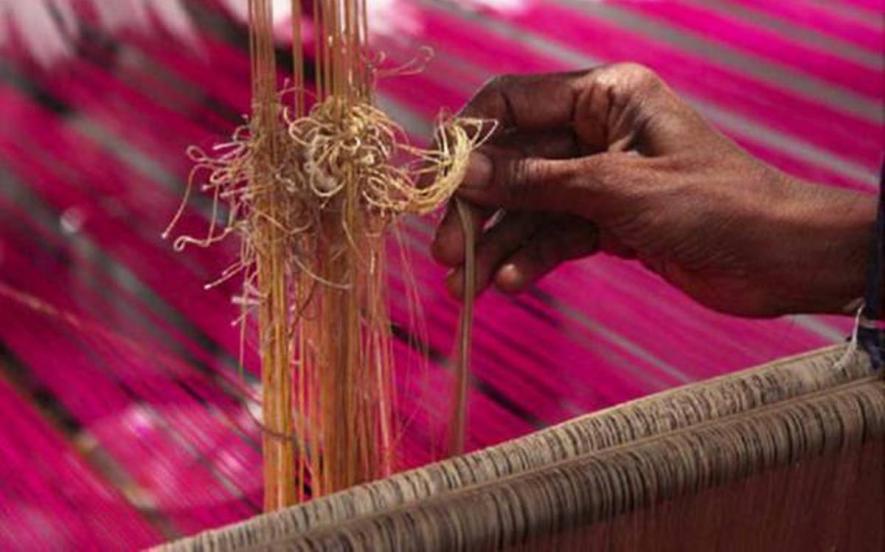Thousands of Weavers in UP’s Mau and Azamgarh say They’re Eating Once a Day

Representational image. | Image Courtesy: The Hindu
We eat only once a day and then think about what we will have later, says Mohd Abu Saleh, a resident of Muhammadabad tehsil in Eastern Uttar Pradesh’s Mau district. “We are sustaining ourselves by eating roti and chutney, there’s no money even for medical treatment”, Saleh further elaborates in a seven-minute video shared with NewsClick.
“If I need Rs 100, neighbours pitch in and lend Rs 10 with which I buy chillies used in the chutney. That’s how we are carrying on”, Saleh says, his eyes looking straight into the mobile camera. His face still doesn’t reveal the helpless state the COVID-19 lockdown has pushed him into.
In the video, at 1 minute and 46 seconds, Saleh breaks down: ‘Bahut bura haal hai, hum log rote rehte hain. Kaise hum logon ka guzara hoga? Magar government sirf aashwasan deti hai, karti kuch nahi hai hamare liye (Situation is really bad and we are really in deep distress. The government only keeps on giving assurances but does nothing).”
Saleh, a weaver, is among 75,000 handloom workers in Mau district, which has a population of around 22 lakh, as per the 2011 Census.
Weavers Hit by Economic Distress
On April 22, as many as 28 days after the COVID-19 lockdown had been enforced across UP, with local administration invoking Section 144, barring public movement and gathering of people, the first alert on the economic distress among the weaver community came from Kasim Ansari, a local activist.
In a press note, Ansari urged the authorities concerned “to issue monthly rations on the basis of Bunkar Card and bank passbooks as 70 percent of weavers in Mau don’t have a ration card in their name.”
Speaking with NewsClick over phone, Ansari described the dire condition of around 50,000 weaver families spread across more than 30 municipal wards, struggling to get two square meals a day ever since the manual looms came to a halt.
“Most of the transactions between the wholesaler and weavers is in cash. On an average, a weaver is able to make two sarees a day and the payment rate is Rs 100 per piece”, said Ansari, listing out the areas that are among the worst hit, such as Ghosi, Kopaganj, Adri and Khairabad.
Maqsood, another weaver from Mau’s Muhammadabad area, said that weekly wages were the sole source of livelihood for people like him. “Because of shutdown, there’s no demand, so even the local mahajan (trader) is not giving us any money”, he told NewsClick.
Aftab, a businessman who employs such weavers, explained the difficulty posed by the sudden drop in demand and its implications. “Frankly speaking, business was already down since the past year, you can say, it reduced to just 10% than what we were making earlier”, says Aftab, who worked in Saudi Arabia almost a decade ago and now runs his own business in Mau.
‘Manchester of Handloom’ Struggling for Survival
Underlying the current plight of weavers is the story of neglect by successive governments, both at the state as well as at the Central level, which pushed these artisans towards penury.
Mau has been known for manufacturing Banarasi sarees, so much so that India’s first prime minister, Jawahar Lal Nehru, had referred to it as the ‘Manchester of handloom’ in 1957. The analogy drew inspiration from the fact that just like Manchester city in England was known as Cottonopolis (for its cotton mills) in the 19th century, Mau was known for its silk sarees back then.
In a 2011 research paper, published by Indian History Congress, Professor Santosh Kumar Rai delved into the glorious past of Mau’s stint with silk. Sometime in the late 18th century, a man by the name of Chittanbaba, who used to weave turbans, impressed the Maharaja of Benares with his work. The king gifted a piece of land, on the outskirts of Varanasi to Chittanbaba, which became a settlement area for weavers.
Artisans from Mau, better known as Mauwaals, shot to fame when they were finally acknowledged at the Lucknow Exhibition of 1835. While weavers from Benaras or Benarasiwals finessed the art of making finer fabrics, the Mauwaals focused on making different kind of textures, including Khinkhwab (mix of silk and golden threads).
Almost two centuries later, in 2016, another research paper published by IJHSSI (International Journal of Humanities and Social Science Invention) highlighted some startling details about the financial status of weavers in Mau. Two research cholars from Aligarh Muslim University, Fatma Mehar Sultana and Mehrun Nisa, conducted a survey among 277 weavers spread across 13 wards and found that the maximum number of weavers (29%) were earning between Rs 100-200 per day. The maximum number of households (40%) were earning above Rs 4,000 per month.
Lopsided policy initiatives continued to be a bone of contention for the weavers of Mau. A year after the research paper by the AMU scholars, in 2017, local newspapers in Mau reported about a protest by local traders against GST or goods and services tax, which was proving to be an additional burden on the weavers, with many of them struggling to understand the online system of payment.
Weaver Community Raises Alarm in Azamgarh
Almost 50 km away from Mau is Mubarakpur area in Azamgarh district, mainly inhabited by members of the weaver community. A week after Mau-based activist, Kasim Ansari, raised an alarm, on April 29, Vinod Yadav, a lawyer based in Azamgarh, got a frantic call. The caller was a weaver from Mubarakpur who needed his help in buying a packet of milk. Yadav had been working as a volunteer for Rihai Manch, a human rights organisation that was providing aid to the needy during lockdown. So, he immediately sprang into action and ensured that the family got what they needed.
Sensing that the impending COVID-19 economic crisis is bigger than what one could comprehend, local Bahujan Samaj Party MLA from Azamgarh, Shah Alam, submitted a list of 27,000 weavers to the district administration, requesting that funds from the chief minister’s relief fund be disbursed immediately.
Javed, a saree trader based in Azamgarh, told NewsClick: “While there is little help from the government, the cooperative societies set up for weavers’ welfare are also defunct institutions.”
The claim about cooperative societies or microfinance institutions, meant for boosting growth of small industry, being reduced to redundant bodies, is not entirely unfounded. In 2016, a report published by BIRD (Bankers Institute of Rural Development) that comes under NABARD, admitted that “District Central Cooperative Banks in Mau, Azamgarh, Balia and Varanasi etc with large weaver concentration are financially weak and not able to provide fresh finance.”
Sudhir Panwar, former member of UP Planning Commission, also concurs with the notion that it was ‘the interference of government in local cooperative societies which reduced them into government appendages.’
Shujat, another Azamgarh-based activist, associated with the Bunkar Mazdoor Union told NewsClick,: “Even as the market price of a saree has increased in the last 10 years, daily wages of labourers have remained the same. We have written at least 15-20 letters to the local authorities in last seven-eight years, but there has been no reply.”
There was no response from the DM of Mau district at the time of writing this story. This reporter sent an email as well sought an official response regarding relief work provided by district administration. The story will be updated as and when there is a response.
112 Helpline Flooded With Calls
In October 2019, UP chief minister Yogi Adityanath launched single helpline number, known as the Emergency Response Support System (ERSS) – 112, which was aimed at redressing the grievances of citizens at district and station level. During the COVID-19 pandemic, this helpline number was the sole support system for those who would reach out to the local DM (district magistrate) and police personnel for delivery of essential services, including ambulances.
In Mau, however, activists who have been interacting with weavers, claim that there was very little awareness regarding the helpline.
When NewsClick reached out to Asim Arun, additional director general of 112 emergency services of UP police, we were told that between March 17 and May 5, there were 3,700 distress calls from Mau that were attended to by personnel manning the helpline no. In case of Azamgarh, the figure for of distress calls received and attended to at 112 helpline no. between 17 March and 5 May stood at 944.
Can Stimulus Package Help?
Even as the assessment of COVID-19 lockdown impact on economy is yet to be ascertained, for thousands of weavers in Mau and Azamgarh, it seems that the worse isn’t over yet. So, shouldn’t the state government consider releasing an economic stimulus as an emergency measure?
Sudhir Panwar feels that ‘financial support for such cottage industry is the need of hour’.
In one of the last audio messages received by this reporter on May 2,from Talha, a local of Mau’s Muhammadabad area, another distressed voice said, “We don’t have ration cards, can something be done about this?”
The writer is an independent journalist.
Get the latest reports & analysis with people's perspective on Protests, movements & deep analytical videos, discussions of the current affairs in your Telegram app. Subscribe to NewsClick's Telegram channel & get Real-Time updates on stories, as they get published on our website.
























